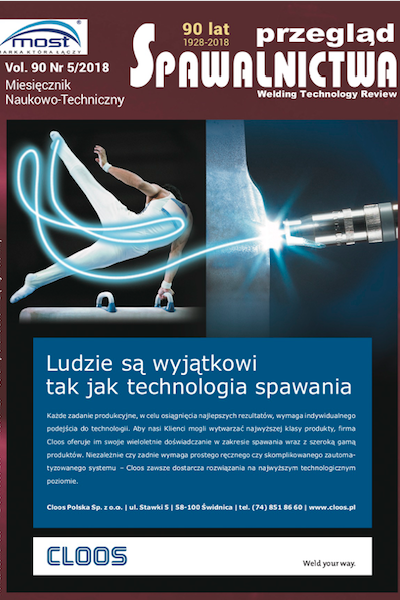Weldability testing of S460N steel in water environment by using Tekken test
Main Article Content
Abstract
Welding in a water environment carries out a lot of problems, among which the most important could be the susceptibility of steel to cold cracking. There are many methods to prevent these cracks during welding in the air, which couldnt be use in wet welding conditions. For the reason, it is necessary to determine the susceptibility of steel to cold cracking. The paper presents experimental evaluation of the welda- bility of fine-grained high strength low alloy S460N steel wet welded by coated electrodes. From the results of Tekken tests it was found out that the investigated steel is char- acterized by the high susceptibility to cold cracking. It is necessary to look for a method that allows to overcome this problem.
Downloads
Article Details
Creative Commons CC BY 4.0 https://creativecommons.org/licenses/by/4.0/
Welding Technology Review (WTR) articles are published open access under a CC BY licence (Creative Commons Attribution 4.0 International licence). The CC BY licence is the most open licence available and considered the industry 'gold standard' for open access; it is also preferred by many funders. This licence allows readers to copy and redistribute the material in any medium or format, and to alter, transform, or build upon the material, including for commercial use, providing the original author is credited.
References
Fydrych D., Rogalski G., Łabanowski J.: Problems of underwater welding of higher-strength low alloy steels, Institute of Welding Bulletin, vol. 58, iss. 5, 2014, pp. 185-190.
Rogalski G., Łabanowski J., Fydrych D., Tomków J.: Bead-on-plate welding of S235JR steel by underwater local dry chambet proces, Polish Maritime Research, 21, 2014, pp. 58-64.
Hu Y., Shi Y.H., Shen X.Q., Wang Z.M.: Microstructore, pitting corrosion resistance and impact toughness of duplex stainless steel underwater dry hyperbaric flux-cored arc, Materials, 10 (12), 2008, pp. 1443.
Gao W.B., Wang D.P., Cheng F.J., Deng C.Y., Xu W.: Underwater wet welding for HSLA steels: chemical composition, defects, microstructures, and mechanical properties, Acta Metallurgica Sinica (English Letters), 9, 2015, pp. 1097-1108.
Gao W., Wang D., Cheng F., Deng C., Liu Y., Xu W.: Enhancement of the fatigue strength of underwater wet welds by grinding and ultrasonic impact treatment, Journal of Materials Processing Technology, 223, 2015, pp. 305-312.
Fydrych D., Łabanowski J., Tomków J., Rogalski G.: Cold cracking of underwater wet welded S355G10+N high strength steel, Advances in Materials Science, vol. 16, 2015, pp. 48-56.
Rogalski G., Fydrych D., Łabanowski J.: Ocena możliwości naprawy rurociągu podwodnego ze stali API 5L X65 przy zastosowaniu spawania mokrego, Przegląd Spawalnictwa, nr 5, 2015, s. 83-90.
Sun Q.J., Cheng W.Q., Liu Y.B., Wang J.F., Cai C.W., Feng J.C.: Microstructure and mechanical properities of ultrasonic assisted underwater wet welding joints, Materials & Design, 103, 2016, pp. 63-70.
Fydrych D., Rogalski G., Tomków J., Łabanowski J.: Skłonność do tworzenia pęknięć zimnych złączy ze stali S420G2+M spawanej pod wodą metodą mokrą, Przegląd Spawalnictwa, nr 10, 2013, s. 65-71.
Padilla E., Chawla N., Silva L.F., dos Santos V.R., Paciornik S.: Image analysis of cracks in the weld metal of a wet welded steel joint by three dimensional (3D) X-ray microtomography, Materials Characterization, 83, 2013, pp. 139-144.
Kurji R., Coniglio N.: Towards the establishment of weldability test standards for hydrogen-assisted cold cracking, The International Journal of Advanced Manufacturing Technology, 77, 2015, pp. 1581-1597.
Świerczyńska A., Fydrych D., Rogalski G.: Diffusible hydrogen management in underwater wet self-shielded flux cored arc welding, International Journal of Hydrogen Energy, vol 42, iss 38, 2017, pp. 24532-24540.
Guo N., Yang Z., Wang M., Yuan X., Feng J.: Microstructure and mechanical properties of an underwater wet welded dissimilar ferritic/austenitic steel joint. Strength of Materials, 47, 1, 2015, pp. 12-18.
Fydrych D., Łabanowski J., Rogalski G., Haras J., Tomków J., Świerczyńska A., Jakóbczak P., Kostro Ł.: Weldability of S500MC steel in underwater conditions. Advances in Materials Science, vol. 14, iss. 2, 2014, pp. 37-45.
Omajene J.E., Martikainen J., Wu H., Kah P.: Optimization of underwater wet welding process parameters using neural network, International Journal of Mechanical and Materials Engineering, 1, 2014, pp. 9-26.
Łabanowski J., Prokop-Strzelczyńska K., Rogalski G., Fydrych D.: The effect of wet underwater welding on cold cracking susceptibility of duplex stain- less steel, Advances in Materials Science, vol. 16., iss. 2, 2016, pp. 68-77.
GaraÅ¡ić I., Krajl S., Kožuh S.: Investigation into cold cracking in under-water wet welding of API5L X70 steel, Transactions of FAMENA, 3, 2009, pp. 25-34.
Pańcikiewicz K., Zielińska-Lipiec A., Tuz L., Rakoczy Ł.: Ocena skłonności do pęknięć zimnych złączy spawanych stali w próbie implantacyjnej, Przegląd Spawalnictwa, nr 4, 2016, s. 63-65.
Kannengiesser T., Boellinghaus T.: Cold cracking tests-an overview of present technologies and applications, Welding in the World, 1, 2013, pp. 3-37.
Zhang H.T., Dai X.Y., Feng J.C., Hu L.L.: Preliminary investigation on real- time induction heating-assisted underwater wet welding, Welding Journal, 1, 2015, pp. 8-15.
Fydrych D., Tomków J., Rogalski G., Łabanowski J.: Wpływ techniki ściegu odpuszczającego na spawalność stali S355G10+N pod wodą, Przegląd Spawalnictwa, nr 9, 2015, s. 29-33.
Fydrych D., Świerczyńska A., Rogalski G., Łabanowski J.: Temper bead welding of S420G2+M steel in water environment, Advances in Materials Science, vol. 16, iss. 4, 2016, pp. 5-16.
